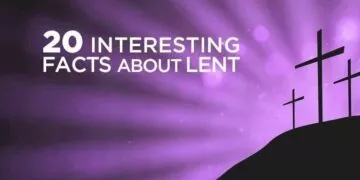Easter Friday is associated with bunnies, chocolates, and – for many people – time off work! It arrives at the beginning of spring and is often seen as the bridge between winter and summer.
You might be wondering about the origins of this Christian holiday and why it is celebrated every year.
You may also be curious about what makes Easter Friday so special, and why it’s observed by thousands of people worldwide.
Read on, and we’ll put your Easter curiosity to rest with these festive facts!
Easter dates are determined by the full moon.

The dates for Easter are calculated according to the moon. People living in the northern hemisphere celebrate Easter once they have seen a full moon on or after the spring equinox.
For those living in the southern hemisphere, this is the autumnal equinox – typically around March 21.
There has not always been a standard method for determining the annual Easter dates. However, this method, which was preferred by the Council of Nicaea in AD 325, ultimately became the accepted standard.
While the equinox does not strictly fall on March 21, this date allows scientists to calculate Easter dates for years in advance.
Not everybody celebrates Easter Friday on the same date.

Easter Friday, also known as Good Friday, is observed around the world on different dates depending on which calendar they use, and which branch of Christianity they follow.
In the Gregorian calendar, followed by much of the Western world, Easter typically occurs during late March or early April.
Christians in the Orthodox Churches, such as the Russian, Greek, or Georgian Orthodox Churches, mark Easter later, during April or early May.
March 31 and April 16 are the most common Easter dates.

While Good Friday and Easter Sunday fall on different dates each year, certain dates are more likely than others.
These two dates are the two most frequent dates for Easter during the period between A.D. 1600 to 2099.
The least common Easter dates within this 500-year time period are March 22, April 24, and March 23.
Easter Friday marks the death of Jesus in the Christian calendar.

Jesus is said to have died on a Friday afternoon in A.D. 33. The day falls before the Passover and the Sabbath, which were on Saturday and Sunday, respectively.
According to the Bible, Jesus shares a final meal with his disciples, known as the Last Supper. Many scholars believe that this happened on a Thursday, the evening before his death on Easter Friday.
There is some disagreement over whether the Last Supper happened before or after Passover. However, Jesus and his disciples would have followed the Jewish lunisolar calendar, where the date of Passover is flexible.
Good Friday was also known as “Holy Friday”.

Back in the days of the Bible, the word “good” was synonymous with “holy.” Therefore, Good Friday was also known as Holy Friday.
The Bible teaches that Jesus was crucified to pay the price for the sins of the world. Christians believe that they are drawn to Jesus and encouraged to be better or more holy as a result.
For many Christians, Good Friday is part of a “Holy Week.” The week lasts for eight days and begins on the Sunday before Easter Sunday, known as Palm Sunday. This was the day that Jesus came to Jerusalem.
Christians worldwide observe Easter Friday in different ways.

Around the world, Christians come together in churches to mark the Easter period, including Easter Friday. Many churches host Good Friday services, which include Bible readings and hymns.
Processions and parades before the church services might also be seen in some Christian communities. Some use this day as an opportunity to show remorse for their wrongdoings.
In Greece, for example, people form a procession into the church – much like a funeral. Others fast and pray throughout the day.
While decorations and embellishments are often seen in churches, some Christians remove these on Good Friday. This is the case in Anglican churches, where flowers and altar decorations are taken down.
Planting crops is an Irish tradition on Easter Friday.

Traditionally, farmers in Ireland believed that crops would grow better if they were planted on Easter Friday. This long-held belief applied to many plants and crops, including potatoes, garlic, and shrubs.
Garlic grown on Good Friday was given to people in an attempt to help cure coughs and even tuberculosis. It was planted before noon on Easter Friday and was ready to be harvested later in the year, usually between August and December.
Planting oats on Good Friday was also thought to bring good luck. Farmers believed that their oats would never rot if they were planted on this sacred day.
Thousands of people retrace Jesus’ steps on Easter Friday.

Roman Catholics and Protestants come together in Jerusalem to walk the same route Jesus took before his death.
Jerusalem was the city where Jesus is believed to have lived and performed miracles.
People carry crosses, pray in Latin, and sing hymns as they walk through the Old City during this major annual event.
In some years, a reenactor even dresses up as Jesus Christ and walks at the head of the procession carrying a wooden cross and wearing a crown of thorns.
Easter Friday is a public holiday for millions of people.

In the United States, people living in twelve states are lucky enough to get the day off work on Easter Friday. Although it is not a federal holiday throughout the country, it is celebrated in states including Florida, Hawaii, North Carolina, and Texas.
Banks, schools, restaurants, and shops are closed on Easter Friday in states that recognize this day as a state holiday.
Outside of the United States, Good Friday is a public holiday in several other countries. These include the United Kingdom, Australia, Greece, Canada, Lebanon, and parts of France.
Not all Christians observe Easter Friday.

While millions of people observe Easter as an important annual holiday, this is not true for all Christians.
Some denominations, such as Protestant Reformed Christians, criticize Easter as they believe it came from pagan traditions related to spring.
Other Christian groups reject Good Friday and the Easter holidays entirely. Among these are Quakers and Jehovah’s Witnesses.
Easter Friday brings a fascinating historical story and plenty of fun traditions for the whole family.
You might feel inspired to visit a local church, take part in an Easter parade, or plant some vegetables in your garden!
However you spend Easter this year, you’re now clued up with lots of festive facts!


















